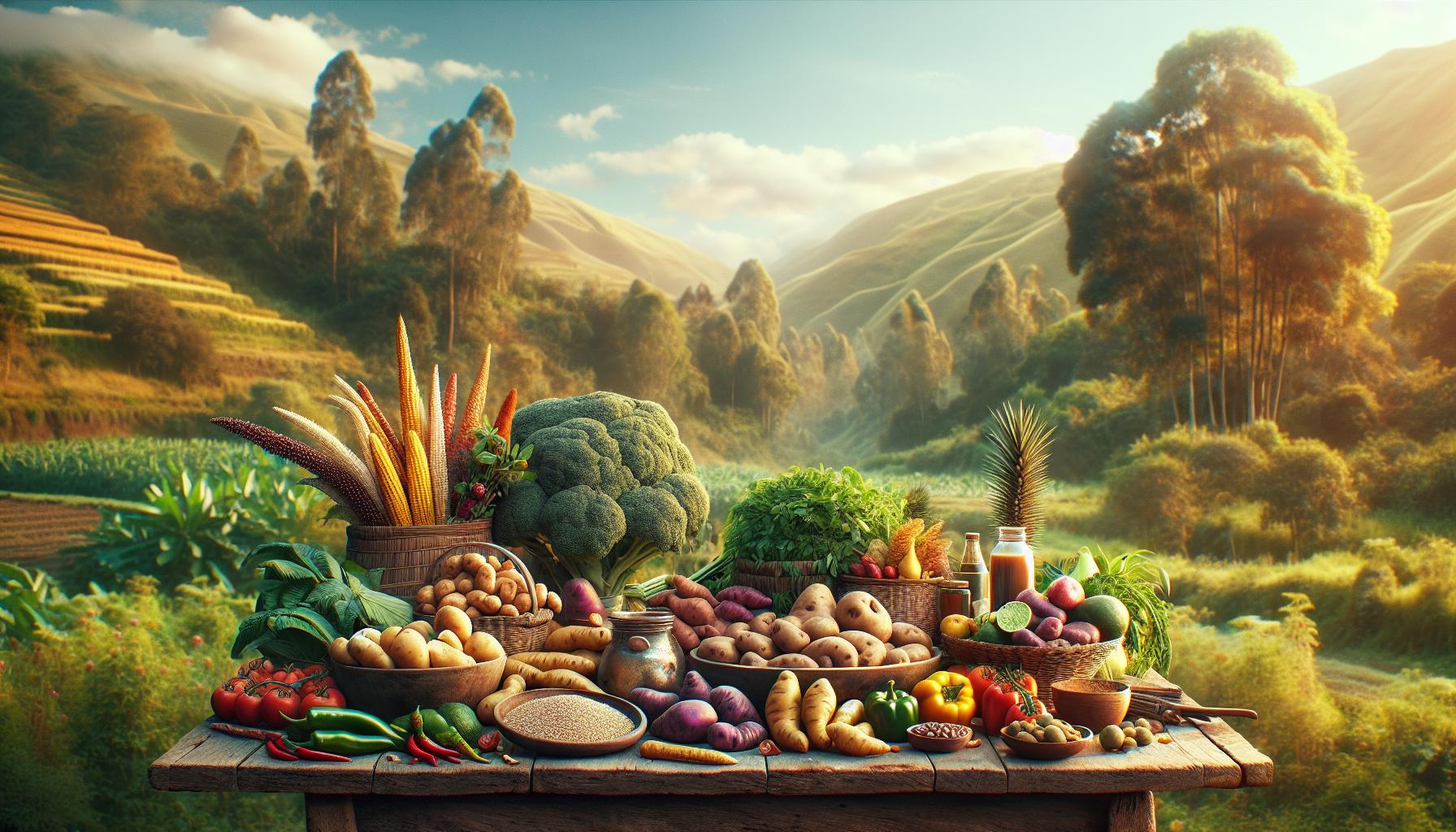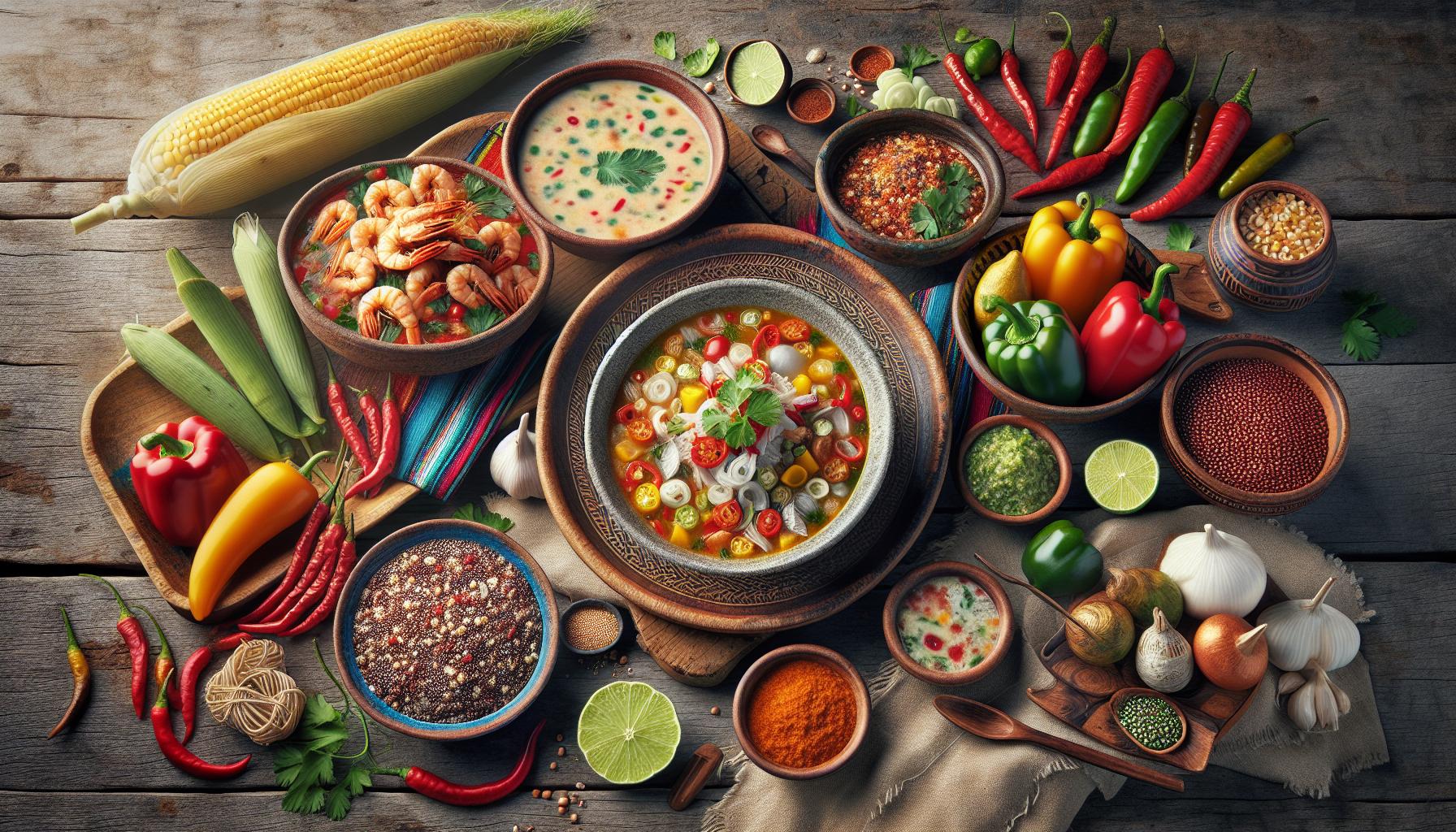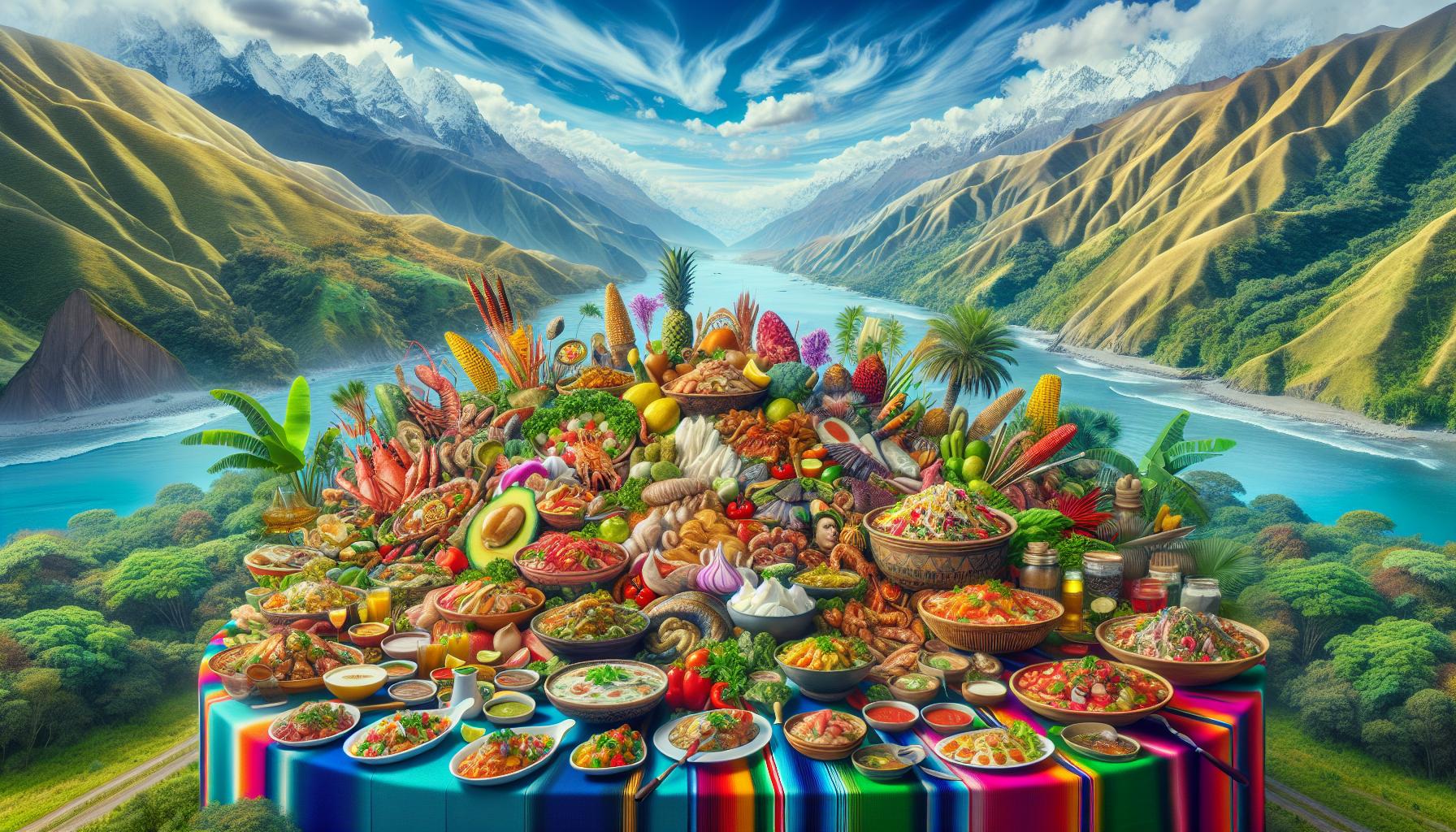Peruvian cuisine tantalizes taste buds with its extraordinary fusion of indigenous, Spanish, African, and Asian influences. It’s a culinary journey that spans from the heights of the Andes Mountains to the depths of the Amazon rainforest, creating a gastronomic tapestry unlike any other in South America.
The world has fallen head over heels for Peru’s vibrant food scene, and it’s easy to see why. From the zesty citrus burst of ceviche to the humble yet mighty potato – which boasts over 4,000 varieties native to Peru – this country’s cuisine tells a story of cultural diversity, ancient traditions, and bold innovation. Whether it’s street food in Lima or a traditional pachamanca feast cooked underground, Peruvian food culture isn’t just about eating – it’s about celebrating life through flavors that dance on the tongue.
Peru Culture Food
Traditional Peruvian cuisine blends 500 years of cultural influences from Indigenous Andean civilizations African slaves European colonizers Chinese laborers Japanese immigrants. Ancient Incan agricultural practices contribute to Peru’s modern food diversity with 4,000 native potato varieties 55 corn types 2,000 fish species.
| Cultural Influence | Time Period | Key Contributions |
|---|---|---|
| Indigenous Andean | Pre-1500s | Potatoes, quinoa, corn |
| Spanish Colonial | 1500s-1800s | Citrus, dairy, livestock |
| African | 1500s-1800s | Anticucho, tacu-tacu |
| Chinese | 1800s | Chifa cuisine, stir-fry techniques |
| Japanese | 1900s | Raw fish preparation, Nikkei fusion |
Regional cooking techniques showcase distinct culinary traditions:
- Coast: Raw seafood preparations ceviche tiradito
- Andes: Earth oven cooking pachamanca huatia
- Amazon: Leaf-wrapped grilling juane patarashca
Sacred food rituals connect modern Peruvians to their ancestral roots:
- Pachamama offerings honor Mother Earth
- Chicha corn beer ceremonies mark harvests
- Community cooking events strengthen social bonds
- Traditional food preservation methods maintain cultural knowledge
UNESCO recognized Peruvian culinary practices as Intangible Cultural Heritage preserving:
- Ancient cooking techniques
- Indigenous ingredients
- Traditional recipes
- Food-related festivals
- Aji pepper spice blends
- Fresh herb marinades
- Fermented food preparations
- Complex sauce compositions
Essential Ingredients in Peruvian Cooking

Peruvian cuisine relies on a diverse array of indigenous ingredients from three distinct geographical regions: the Andes, the coast, and the Amazon rainforest. These ingredients form the foundation of traditional dishes that have evolved over centuries.
Native Andean Ingredients
The Andean region contributes staple ingredients that define Peruvian highland cuisine. Potatoes originating from Peru come in 4,000 varieties with distinct colors textures flavors. Quinoa grows at high altitudes providing complete protein nutrition in red white black varieties. Corn appears in multiple forms including choclo (large-kerneled corn) cancha (toasted corn) purple corn for chicha morada. Herbs like huacatay (black mint) muña rocoto peppers add distinctive flavors to traditional dishes. Ancient preservation techniques transform potatoes into chuño through freeze-drying processes at high elevations.
Coastal and Tropical Elements
Peru’s 1,500-mile coastline supplies abundant seafood for iconic dishes like ceviche leche de tigre. Ají peppers including ají amarillo ají panca ají rocoto contribute essential heat flavor profiles. Tropical fruits such as lucuma chirimoya granadilla feature in desserts beverages. The Amazon provides unique ingredients like aguaje palm fruit camu camu berries sacha inchi nuts. Fresh lime juice (key to ceviche) comes from coastal citrus groves. Coastal regions cultivate ingredients like yellow potatoes white corn sweet potatoes essential for classic dishes. Amazonian herbs spices including mishqui panga sachaculantro enhance traditional recipes.
Popular Traditional Peruvian Dishes

Traditional Peruvian cuisine features a diverse array of dishes that showcase the country’s rich culinary heritage. These iconic recipes combine indigenous ingredients with international influences to create unique flavors.
Ceviche and Seafood Specialties
Ceviche stands as Peru’s national dish, featuring fresh raw fish cured in citrus juices, typically lime, mixed with red onions, chili peppers, and cilantro. The coastal regions offer variations including:
- Chupe de Camarones – A creamy shrimp soup with corn, potatoes, eggs
- Tiradito – Sliced raw fish in spicy yellow pepper sauce
- Jalea – Mixed seafood fried in a light batter served with yuca
- Parihuela – Concentrated seafood soup with multiple types of fish, octopus, shrimp
- Arroz con Mariscos – Peruvian-style paella with local seafood, yellow pepper paste, peas
Ancient Inca-Inspired Recipes
Inca culinary traditions remain alive through dishes that incorporate ancient cooking methods and native ingredients. Modern Peruvian restaurants serve these traditional plates:
- Pachamanca – Underground earth oven cooking of meats, potatoes, corn
- Quinoa Soup – Traditional Andean grain combined with vegetables
- Cuy – Guinea pig prepared with Andean herbs and spices
- Locro – Thick pumpkin stew with potatoes, corn, cheese
- Choclo con Queso – Large-kerneled Andean corn served with fresh cheese
- Rocoto Relleno – Stuffed spicy peppers with meat, vegetables, cheese
Each dish incorporates indigenous ingredients like quinoa, native potatoes, ají peppers that connect modern diners to Peru’s ancient cultural heritage.
Regional Food Diversity Across Peru

Peru’s culinary landscape reflects distinct geographical regions: the coast, mountains and jungle. Each area contributes unique ingredients traditions to create a diverse tapestry of flavors across the country.
Coastal Culinary Traditions
Peru’s 1,500-mile coastline shapes its seafood-centric coastal cuisine. Fresh catches from the Pacific Ocean form the foundation of iconic dishes like ceviche, leche de tigre and jalea mixta. Lima’s coastal restaurants serve tiradito, a Japanese-influenced dish combining raw fish with spicy ají amarillo sauce. Northern coastal cities like Chiclayo specialize in arroz con pato, while Trujillo offers unique preparations of ceviche with corn and sweet potato. The cold Humboldt Current provides abundant seafood varieties including corvina, lenguado and octopus used in traditional recipes.
Mountain and Jungle Gastronomy
The Andes mountains feature hearty dishes using local ingredients like potatoes quinoa chuño. Traditional mountain preparations include pachamanca, where meats marinate underground with hot stones herbs. Cusco’s chupe de chuño combines freeze-dried potatoes with local cheese spices. The Amazon jungle contributes exotic ingredients like paiche fish plantains yuca. Iquitos restaurants serve tacacho con cecina, featuring grilled plantains pork. Jungle communities prepare juane, wrapping rice chicken in bijao leaves. Regional dishes incorporate wild fruits like camu camu aguaje coconut.
Modern Peruvian Food Revolution
Peru’s gastronomic scene experienced a transformative shift in the 2000s, led by chef Gastón Acurio who pioneered Novoandina cuisine. This contemporary approach combines traditional ingredients with modern cooking techniques, elevating Peruvian dishes to fine-dining status.
Lima’s restaurant scene boasts 3 establishments in The World’s 50 Best Restaurants 2023: Central (#2), Maido (#6) Kjolle (#28). These restaurants showcase innovative interpretations of classic Peruvian dishes, incorporating molecular gastronomy techniques with indigenous ingredients.
Modern Peruvian chefs integrate sustainable practices by:
- Partnering with local farmers to preserve native crop varieties
- Utilizing forgotten Andean grains like kiwicha quinoa
- Creating zero-waste menus from traditional ingredients
- Developing plant-based versions of classic dishes
Fusion cuisine emerges as a defining characteristic of modern Peruvian cooking, exemplified through:
- Nikkei (Peruvian-Japanese) combinations like tiradito
- Chifa (Peruvian-Chinese) evolution with dishes like lomo saltado
- Modern ceviche variations incorporating global ingredients
International recognition continues growing through:
- Opening of Peruvian restaurants in major global cities
- Export of native superfoods like maca purple corn
- Inclusion of Peruvian dishes on international menus
- Recognition from global culinary organizations
The revolution extends beyond restaurants into:
- Food halls featuring artisanal Peruvian products
- Cooking schools specializing in modern techniques
- Mobile apps connecting consumers with local producers
- Television programs showcasing contemporary Peruvian cuisine
This modernization maintains strong connections to Peru’s culinary heritage while introducing innovative preparation methods presentation styles flavors combinations.
The Social and Cultural Impact of Food in Peru
Food unites Peruvian communities through shared culinary traditions that span generations. Families gather daily for extended lunch breaks, treating meals as sacred social occasions rather than rushed necessities. Community celebrations center around traditional dishes that connect modern Peruvians to their ancestral heritage.
Markets serve as vibrant social hubs where vendors share cooking tips, recipes pass between generations, and neighbors exchange daily updates. Local food festivals, such as Mistura in Lima, attract over 500,000 visitors annually to celebrate Peru’s culinary diversity.
Traditional cooking methods strengthen social bonds:
- Huatias bring neighbors together to cook potatoes in earthen ovens
- Pachamancas unite communities for ceremonial earth-oven feasts
- Chicha brewing ceremonies preserve ancient corn-fermenting traditions
Food rituals maintain cultural identity across Peru’s regions:
- Coastal communities honor the sea through seafood-focused celebrations
- Andean villages perform offerings to Pachamama before meals
- Amazonian groups preserve indigenous recipes through oral traditions
Social status no longer dictates access to Peru’s culinary heritage. Street food vendors serve the same beloved dishes as high-end restaurants, creating shared cultural experiences across economic classes. Food tourism generates $1.5 billion annually while empowering local communities to preserve traditional practices.
| Social Impact Statistics | Value |
|---|---|
| Annual food festival visitors | 500,000+ |
| Food tourism revenue | $1.5B |
| Average lunch break duration | 2 hours |
| Traditional markets in Lima | 1,250+ |
Promising Future in the Global Culinary
Peruvian cuisine stands as a living testament to the nation’s rich cultural heritage and diverse geography. From ancient Incan traditions to modern culinary innovations the food culture continues to evolve while maintaining its authentic roots.
The global recognition of Peru’s gastronomy reflects its extraordinary journey from local traditions to international acclaim. This culinary powerhouse not only preserves centuries-old cooking methods but also embraces contemporary techniques that showcase its distinctive flavors to the world.
Through its markets festivals and family gatherings Peruvian food culture remains a powerful force that unites communities and bridges generations. It’s more than just sustenance – it’s a celebration of Peru’s past present and promising future in the global culinary landscape.

